#the textile saga
Note
Omg textiles🤩 it’s been 4and a half years but we got there
YESS!!! It's here and it's happening

13 notes
·
View notes
Text



Elric of Melnibone/Cirith Ungol custom trousers (2023)
Estimated time: 3 days
Material: Faber castell and creabox textile markers
Original illustrations by Michael Whelan x and x
#artists on tumblr#textile art#custom clothes#Custom trousers#elric of melnibone#elric#the elric saga#elric saga#elric of melniboné#cirith ungol#michael whelan#King of the dead#Half past human
18 notes
·
View notes
Text
after some major procrastination i'm finally making a start on the vessel coat for november (plus halloween club nights) and by 'making a start' i mean ordering the fabric. i've only got 9 days of a sewing machine left. i've planned to do this since february. black cotton will be fine right
#person who only ever studied textile art tries to do real sewing#why is it so hard to do things that i actually want to do...#like listen to their songs?? i still haven't finished? what is wrong with me#anyway!! going to tag this saga as#project vessel coat#<- for blocking
8 notes
·
View notes
Text
oh also i've been working on a livio cosplay for fun lately and i'm trying to get it done before halloween. none of the process has been fun to look at so far but uhh.

have some delicious soup
i've had to do so much to this jacket and i'm only like halfway through it. i had to dye it black, (attempt to) remove a design, paint over the ghost of that design, and replace the buttons- and now i need to add belt loops, and a strap Situation for the doublefang guns to attach too that involves 12 sets of snaps and six metal studs. it will be cool though i promise.
#this is what happens if u let the textile based enrichment desire fester for too long#ghostt talks#livio cosplay saga
9 notes
·
View notes
Text
I need to stop drinking or I will start crying over how fascinating historical tax systems are, this is a threat.
#the ongoing saga of navi's niche interests#fucking like#do you understand#how much labor#goes into textile production pre industrialization#and all the food commodities too#like grain and salt and spices and#hurrrrrgh
2 notes
·
View notes
Text


Unlined Summer Kimono
c.1876
A pond with carp and water lilies adorns the lower part of this kimono, and morning glories bloom at the shoulders. This early summer scene is resist dyed and painted on a blue-and-white ground of high-quality silk gauze (ro), subtly patterned in the weave with goldfish in water. The donor’s grandmother, one of four generations of female textile artists, wore this summer kimono during her thirteenth year, around 1876, for her jūsan-mairi (literally, “thirteenth temple visit”) to Arashiyama Hōrinji, a temple in Saga, Kyoto, to receive blessings as she entered adolescence. The kimono has three family crests: one on the center of the back and one on each sleeve.
The MET (Accession Number: 2006.73.2)
#kimono#japanese fashion#fashion history#historical fashion#non western fashion#1870s#19th century#1876#blue#off white#japan#fish#floral#meiji era#the met#popular
1K notes
·
View notes
Note
There is a difference between Bollywood and Bombay cinema?
listen, subcontinental cinema began in bombay; the very first exhibition of the lumieres' cinematographe was held there in 1896, a few months after its debut in paris, 1895. this event predates the discursive existence of bollywood and hollywood. shree pundalik and raja harishchandra, the films that are generally considered the very first subcontinental features were also exhibited there first.
subcontinental cinema under british colonialism was produced in certain metropolitan centers such as lahore, hyderabad, and calcutta; bombay was just one of them. in 1947, when the indian nation state was formally inaugurated, the idea of a "national cinema" began forming, but given the cultural and linguistic heterogeneity of the indian union, this was quite untenable. regional popular cinemas flourished well into the 1950, 60s, 70s, and 80s and various art cinemas began taking shape alongside.
under the economy that i'm going to completely elide as "nehruvian "socialism"" bombay cinema focused on broadly "socialist" themes, think of awara (1951), do beegha zameen (1953), pyaasa (1957), all of which focus on inequality in indian economy and society from different perspectives. these films were peppered in with historical dramas, and adaptations from literature, but the original stories tended towards socialist realism. reformist films centering the family generally waxed poetic on the need to reform the family, but i haven't seen enough of these to really comment on them.
the biggest hit of the 70s, sholay (1975) was about two criminals, posited as heroes fighting gabbar singh who was attacking village folk. deewar (1975) also had two heroes, and the stakes were the two brothers' father's reputation; the father in question was a trade union leader accused of corruption.
"alternative cinema" included mani kaul's uski roti (1969) and Duvidha (1973) both of which were situated away from the city. then there's sayeed mirza and his city films, most of them set in bombay; arvind desai ki ajeeb dastan (1978), albert pinto ko gussa kyun aata hain (1980), saleem langre pe mat ro (1989) which are all extremely socialist films, albert pinto was set in the times of the bombay textiles strike of 1982 and literally quotes marx at one point. my point is that bombay cinema prior to liberalization was varied in its themes and representations, and it wasn't interested in being a "national cinema" very much, it was either interested in maximizing its domestic profits or being high art. note that these are all hindi language films, produced in bombay, or at least using capital from bombay. pyaasa, interestingly enough is set in calcutta, but it was filmed in bombay!
then we come to the 1990s, and i think the ur example of the bollywood film is dilwale dulhania le jayenge (1995) which, in stark contrast to the cinema that preceded it, centered two NRIs, simran and raj, who meet abroad, but epitomize their love in india, and go back to england (america?) as indians with indian culture. this begins a long saga of films originating largely in bombay that target a global audience of both indians and foreigners, in order to export an idea of india to the world. this is crucial for a rapidly neoliberalizing economy, and it coincides with the rise of the hindu right. gradually, urdu recedes from dialogue, the hindi is sankritized and cut with english, the indian family is at the center in a way that's very different for the social reform films of the 50s and 60s. dil chahta hai (2001) happens, where good little indian boys go to indian college, but their careers take them abroad. swadesh (2004) is about shah rukh khan learning that he's needed in india to solve its problems and leaves a job at NASA.
these are incidental, anecdotal illustrations of the differences in narrative for these separate eras of cinema, but let me ground it economically and say that bollywood cinema seeks investments and profits from abroad as well as acclaim and viewership from domestic audiences, in a way that the bombay cinema before it did not, despite the success of shree 420 (1955) in the soviet union; there were outliers, there always have been.
there's also a lot to say about narrative and style in bombay cinema (incredibly diverse) and bollywood cinema (very specific use of hollywood continuity, intercut with musical sequences, also drawn from hollywood). essentially, the histories, political economies, and aesthetics of these cinemas are too differentiated to consider them the same. bombay cinema is further internally differentiated, and that's a different story altogether. look, i could write a monograph on this, but that would take time, so let me add some reading material that will elucidate this without sounding quite as fragmented.
bollywood and globalization: indian popular cinema, nation, and diaspora, rini bhattacharya mehta and rajeshwari v. pandharipande (eds)
ideology of the hindi film: a historical construction, madhav prasad
the 'bollywoodization' of the indian cinema: cultural nationalism in a global arena, ashish rajadhyaksha
the globalization of bollywood: an ethnography of non-elite audiences in india, shakuntala rao
indian film, erik barnouw and s. krishnaswamy (this one's a straight history of subcontinental cinema up to the 60s, nothing to do with bollywood, it's just important because the word bollywood never comes up in it despite the heavy focus on hindi films from bombay, illustrating my point)
438 notes
·
View notes
Text
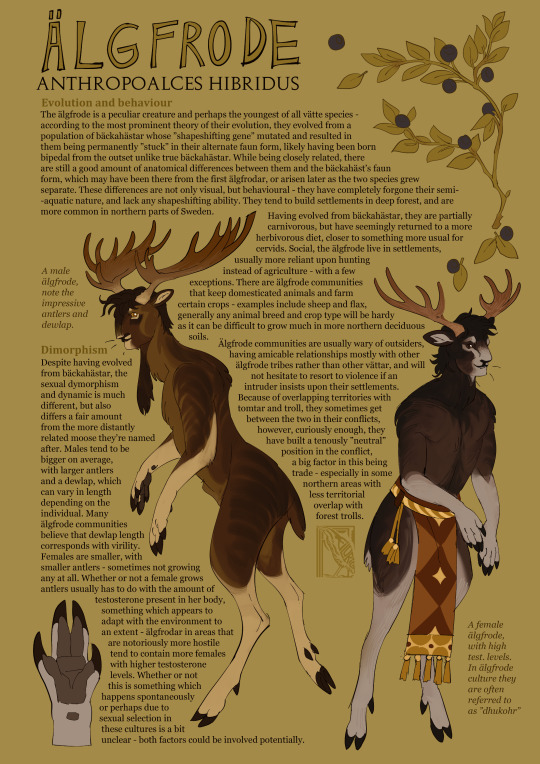
its been a while but new pareidolia creature!! ive been thinking of making these for a while. in case u don't know what an älgfrode is (a bit more of a niche nordic mythology creature), an älgfrode (or elgfróði in icelandic) was mentioned in hrólfs saga kraka, one of the old norse hero sagas. while the context for that was one specific character i just wanted to make moose people..
more info abt my creatures below the cut...
they wear more clothes than in the ref this is just to show their anatomy LOL. clothing is actually very important to them and textiles will almost always have a role in any tradition/significant social event. their textilework is very renowed and is one of the trades that cause some other vättar to want to trade with them as mentioned in the ref!
one potential reason for their high level of defensiveness is that their species suffers from a higher than average infant mortality rate - with time, this mortality rate has lowered from what it used to be, but when the species first appeared, it wasn't unusual for a mother to have to give birth to many calves before one even made it to adulthood. this rooted a deep set vigilance in them - even now that the rates have stabilised a bit. the high mortality rate was probably due to the affected "shift" gene sometimes activating improperly which could result in stillborns. with time and selective pressure new gene mutations would arise in the species that "counteracted" the instability of the first initial one and made the infant mortality decrease. it is, however, still a little higher than usual for similar species, and so it is traditionally encouraged to have many children.
gender roles for älgfroder are interesting - there is a strong sense of "equal strength", or "laorhgr" in älgfrode, which is important. while males are usually slightly larger than females, there is emphasis on the importance on a pair being able to stand their ground both physically and emotionally to the other and a relationship can only go ahead if a spar between two älgfroder is fair. this extends to an interesting dynamic that involves polyamory. älgfroder can be both monogamous and polyamorous, however polyamorous relationships often only arise when there is a big physical differential between two parties. the belief is that if one party is stronger than the other, that strength can be equalised if the other party is accompanied a second partner of similar strength - usually this happens between one strong male and two females on the smaller end. that way the resulting relationship has achieved "laorhgr". this ofc varies as everything does but ya. basically if you are a big strong älgfrode dating a small petite älgfrode it's seen as shameful and barbaric. there is also a bias to heterosexual relationships as it is seen as an important social duty to at least successfully raise one calf.
dhukohr are the more commonly occuring intersex condition in älgfrodar, but there is an equivalent to it for "males" where they fail to grow antlers and have very small dewlaps due to low testosterone levels - those are usually referred to as kvikohr. they are often recognised as their own gender respectively however there are many that identify as men/women too. some of these dhukohr/kvikohr are actually moreso trans than intersex - simply having utilized faerie dust in order to transition. this can be a bit of an ordeal though because usually this requires being administered it by a tomte which, depending on the settlment, can be a tense negotiation, although individuals usually have a less hard time with that.
älgfrodar and bäckahästar can hybridise and do sometimes produce fertile offspring! i would have to think more about this though erm. but i think it does and can happen. there is a sense of rare camraderie between the two species in many cases but especially so between älgfrodar and bäckahäst communities that choose to spend more time as their faun shift than their base shift - in fact a few of these bäckahästar choose to integrate into certain älgfrode settlements, but this is more of a rare occurance. most bäckahästar that possess "unishift" clothing have actually had them made by älgfrodar, or at least had the fabric sourced from them
#pareidolia tag#bestiary#faun#fantasy#speculative fantasy#specbio#speculative biology#speculative evolution#folklore#worldbuilding#creature lore
178 notes
·
View notes
Text
Byerly Vorrutyer Character Designs
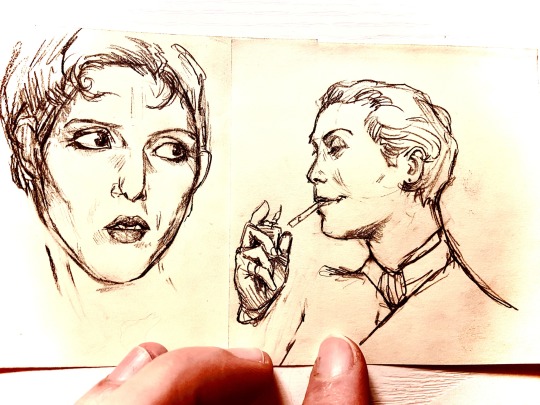
BYERLY VORRUTYER of Lois McMaster Bujold’s Vorkosigan Saga
Tried to go for a rapidly-aging prettyboy with the gothic heavy lidded eyes (idk how to describe the eyes I’m talking about) and a face that reads as male while having something slightly feminine about it. A face that smiles often but is composed, cool. Slightly wavy black hair that is either shortish, chin length, or slightly shorter than shoulder length (I haven’t decided yet 😅)
Designing faces is not my strong suit so I am working backwards from a few references I like. Will probably simplify artstyle, slightly lengthen hair and mix with a dash of Professor Venom from OK KO (for that little bit of haggard twink energy) to creat the final design.
References:
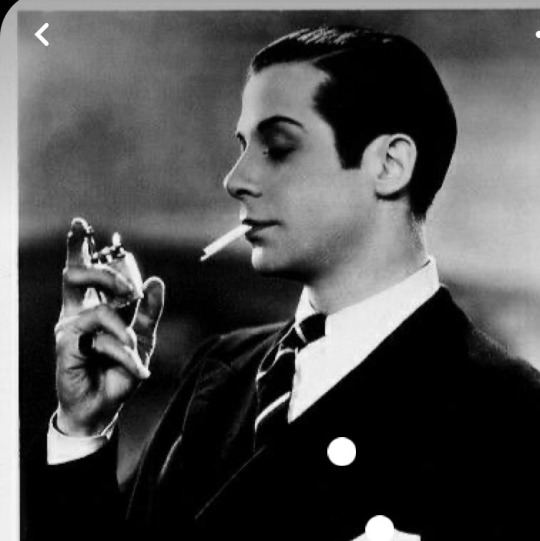
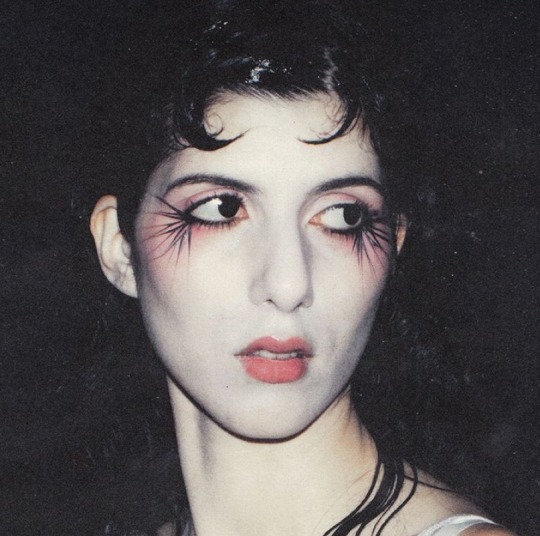
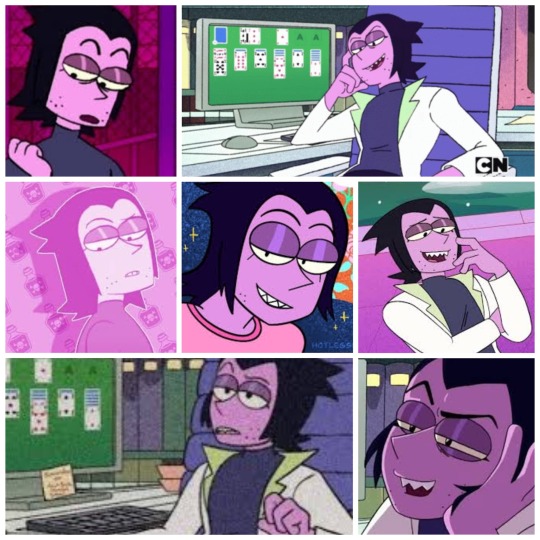
Wardrobe:
Materials: silk, velvet, ruffles lace, detailed embroidery, military piping, sheer cloth, fur — echoes of beautiful luxurious handmade traditional artisan clothing- but all a little to gaudy and cheaply produced - the barrayaran aristocrat version of fast fashion. Androgynous and galactic styles occasionally thrown in to add to mystique
-SHIRTS: silk shirts // shirts with poofy or frilly sleeves // patterned shirts // sheer shirts // velvet shirts // shirts that are tucked in the pants but so unbuttoned the entire chest exposed
- SUITS: velvet suits that absolutely reek of cologne // sleezy yet sharp barreyaran style black suits you might smoke a cigar or play pool in // pastel suit for daytime garden parties
WARDROBE ACCENTS
- bigass fur coat - maybe even almost a midieval king robe
- several offensively knock off fast fashionmilitary style jackets
- luxuriously patterned bathrobe
- see through shawl / wrap / night robe thing
- some gaudy galactic style outfits
- a few sexy or frilly dresses to piss off the family
- a few a casual / slightly more subdued blend of komarran, barrayaran and practical galactic clothing he only really wears at home (stuff he wears when he’s not preforming for an audience). maybe some sentimental pieces. What’s hidden beneath the camouflage.
- some bling: rings and earrings. A few broaches and cuff links probably not that many necklaces
EDIT: here are some reference collages I put together! Note that these references aren’t the exact items that he would have in his closet but rather there are aspects to each piece that I would want to incorporate into his design. Maybe it’s the cut of a sleeve, the silhouette of a coat, the way a robe drapes, the embroidery pattern on some fabric, or the general partied-too-hard vibes of a particular photo of a model.
Bastardized military jackets:
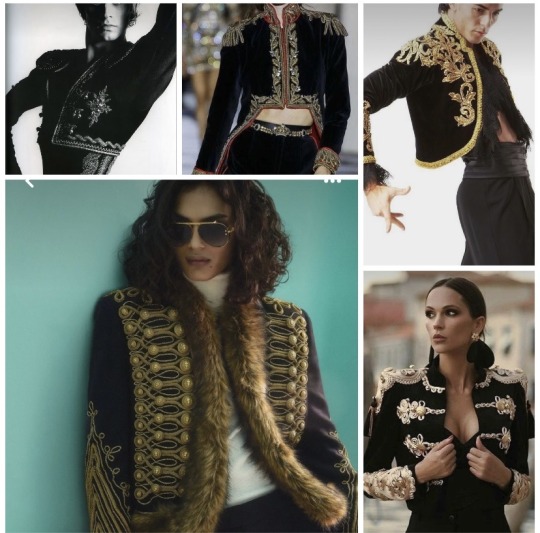
Neglige options / heavier nightfrobe options:
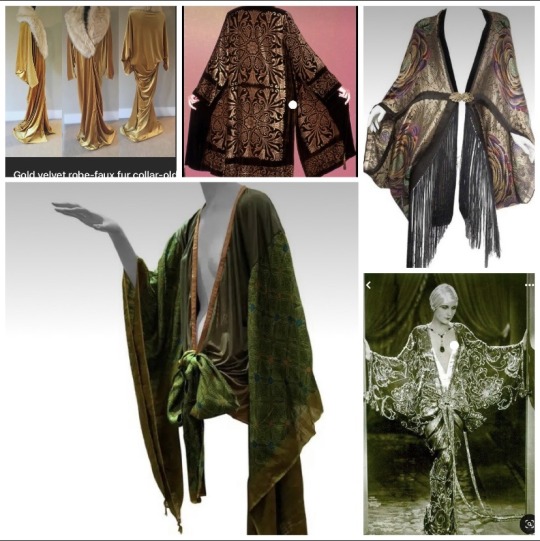
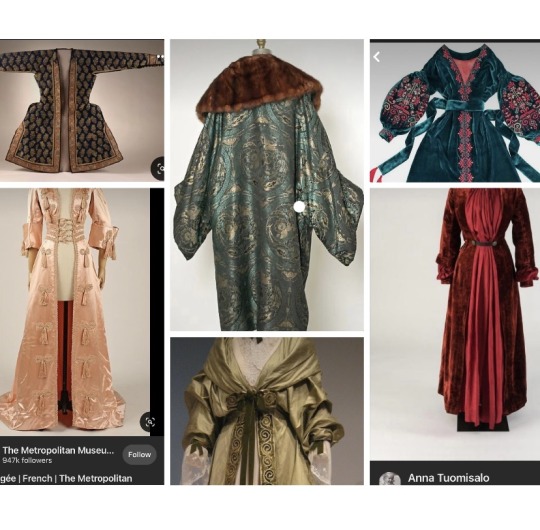
Bigass fur coat:
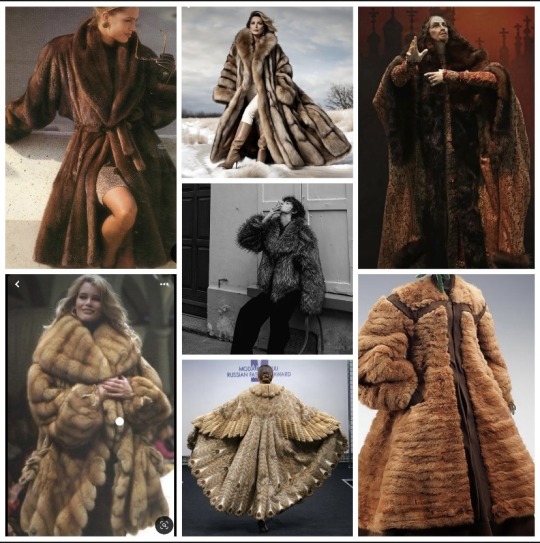
Shirts (please ignore the long blue scarf in the central image like wtf is that- the rest of the suit is nice tho):

Party vibes:
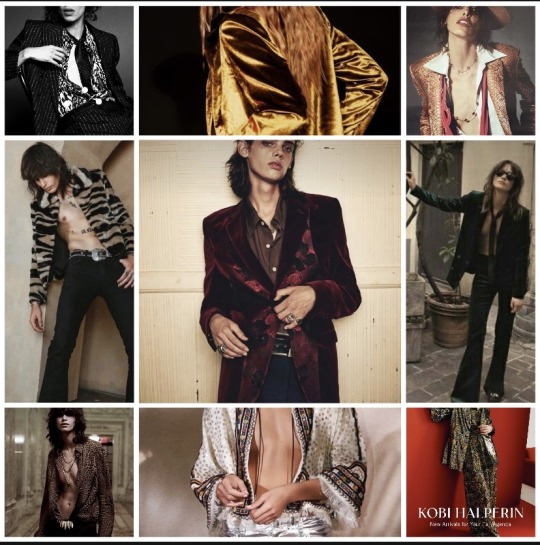
A lot of these aspects would then be mixed with my own head cannon for the rules/cuts of barreyaran mens clothing (I went to a library and spent a stupid insane amount of time looking through books with midieval, 1800s and 1900s men’s fashions and France, Russia, and Greece- + additional books of traditional folk clothings and textile patterns + several other books of historic military uniforms…. The process and choices were so long that I had to give up and just stop thinking about any sort of vorkosigan related character design for a couple months cuz my head hurt. - I will probably make another post at some point with more annotated collages and possibly some of my own drawings synthesizing the concepts, but uh not right now because I need a nap just thinking about trying to organize it all.)
If you’d like to see a little more of vorkosigan universe costume imaginings here’s my Pinterest board on it (kinda) https://pin.it/2rOoHsq it’s a extremely disorganized and from early hyperfixation days so none of my fashion history research stuff is there (cuz that was all physical book stuff) but uh, you can look at it if you want.
P.S.
If you have any feedback or critiques on the design so far, or ideas for how you think By should look, let me know! I love hearing other people’s interpretations 😊.
Photos of faces you think look like By, pictures of outfits that feel Byerly-ish, or direct quotes from the books about his demeanor or appearance are also welcome!
@starfishlikestoread it’s been approximately a thousand years but I’m finally getting around to that Byerly fanart! Hope you enjoy 😅
#vorkosigan saga#lois mcmaster bujold#scifiart#fanart#character design#wardrobe#costume design#Byerly Vorrutyer#art#long#long post
65 notes
·
View notes
Text
The Magic of the Lace-Up Top: Charm and Mischief Unleashed
Welcome, fashion lovers and summer fun enthusiasts, to a new chapter in the saga of garments that make us go “wow” (or perhaps a bit more). Today, let’s talk about the lace-up top, that bold piece that plays hide and seek with decency while openly flirting with danger.
Ah, the lace-up marvel: as ingenious as it is intriguing. Who would have thought that a bit of yarn and a few knots could dominate conversations and attract admiring (or perhaps envious) glances? This piece is not just clothing; it’s a veritable manifesto of textile bravery.
The top appears modest, but with the slightest movement, it transforms into a game of wits, where each lace moves strategically like a double agent in a spy story. And like in the best thrillers, the audience is left wondering: “Will it hold or will it betray?”
The real allure of this top lies in its unpredictability. Every outing is an adventure; every motion a mystery. Will today be the day the top decides to cooperate, or unleash chaos in the bustling heart of the city?
So, as you contemplate adding this bold piece to your summer wardrobe, remember: the lace-up top is not just a piece of clothing. It’s a nerve test, a flirtation with fate, a breathtaking dance on the edge of the unforeseen. Wear it with caution, but above all, with a dash of daring!

#melons#big areola#jen#gazongas#bazookas#floppy#huge natural melons#nipplicous#huge#bazongas#seethrough
10 notes
·
View notes
Text
Hateread de Tara Duncan tome 10 – Dragons contre démons - Chapitre 22
Ceci est un Hateread du tome 10 de la saga Tara Duncan, inspiré par le long travail de Patricklemorse. Pour plus d’explications ou d’introduction, référez vous au post « Hateread de Tara Duncan tome 10 – Dragons contre démons - 0 : Dans les épisodes précédents » !
L’ensemble des extraits cités entre guillemets et en italiques appartiennent à madame Sophie Audoin-Mamikonian, que j’appellerai Madame S.A.M par facilité.
Bonjour à tous !
Comme je le disais dans l’article précédent, pour m’excuser de ma lenteur caractéristique, je livre trois reviews de chapitre plutôt qu’une seule cette fois-ci (les reviews des chapitres 21, 22 et 23).
La dernière fois, nous rencontrions enfin un changelin, Monsieur X, qui avait l’horrible idée d’embrasser une mineure sous l’apparence de son ex-petit ami. Nous apprenions aussi la machination ayant donné lieu aux missions d’assassinat.
Mais bon, nous allons laisser ça de côté pour retrouver Mara dans un chapitre que j’espère être moins pénible que le dix-neuvième, intitulé « Mara, ou comment faire du vaisseau spatial-stop. »
Let’s go
« Mara essuya son poignard. Devant elle, le cadavre de Selenba gisait, dans une mare de sang.
Elle releva la tête vers la silhouette holographique ténébreuse de Magister qui la regardait en silence.
La jeune fille était détendue. Elle avait fait exactement ce que voulait Magister. Elle désigna le corps de son couteau et demanda dédaigneusement :
— Voulez-vous que je lui tranche la tête et que je vous la rapporte ? Ce sera salissant, mais ça ne me gêne pas.
Magister semblait surpris.
— Comment as-tu fait ? fit-il de sa voix de velours liquide. »
Même s’il est évident que tout ça est mis en scène et que Selenba n’est pas réellement morte, j’apprécie TRÈS FORTEMENT ce début sans préambule. Surtout après toute l’exposition qu’on s’est chopé au dix-neuvième chapitre. Bon Dieu que ce dix-neuvième chapitre était long.
Ah oui, et sidenote : je ne sais pas si j’ai déjà lu la remarque quelque part, mais « la voix de velours liquide » de Magister est une paraphrase qui me fait beaucoup rire. Je suppose que le velours liquide est un type de tissu (je ne m’y connais pas assez en textile pour le dire), mais pour une non initiée comme moi, on dirait que deux consistances différentes sont associées à un truc qui n’est pas censé avoir de consistance, la voix. Et puis là où je peux me figurer des « pattes de velours », les deux se rapprochant plutôt bien, la voix de velours me rend plus perplexe. Je pense que c’est une façon d’exprimer les intonations plutôt que le ton de voix, mais ça veut dire que Magister a constamment une voix caressante, même quand il se transforme en loup et se vautre sur sa propre queue. Perplexe.
C’est comme si je disais de quelqu’un « je n’ai jamais supporté ses grands airs conditionnés ». Genre ça se voit comme le nez au milieu de la figure qu’il s’agit d’une image, mais alors va te conceptualiser l’image mon gars.
« — Selenba a été transformée en vampyr normale, elle n’était plus le Chasseur, répondit Mara en dévoilant son bras cassé qui pendait et l’énorme entaille souillée de sang sur son ventre. Elle a commencé à m’expliquer qu’elle voulait avoir une vie « normale » et blablabla, elle n’a pas vu en moi l’assassin, elle n’a vu que l’Héritière, même si elle s’attendait à ce que je l’attaque après lui avoir dit que j’avais volé quelque chose pour vous et que vous m’aviez demandé de la tuer en échange. Pour sauver Cal. »
Yay yay yay c’est de nouveau le moment pour moi de parler de découpage de répliques !!
C’est mal foutu !
Voilà !
Plus sérieusement, la première phrase, pas de souci, ça marche. Je dirais même que ça donne à Mara une façon de parler intéressante.
Souvent, quand on écrit, on a la tentation de donner aux personnages des phrases bien pensées et découpées, exprimant un raisonnement digne d’une thèse ; ce qui en soi fonctionne dans certains types de bouquins, pas de problème. Mais personnellement, je suis très fan des histoires où les répliques des personnages reflètent leur psychologie, dans la façon dont elles sont articulées, la taille des phrases, la façon dont les informations sont mises ─ phrases brèves avec toutes les informations nécessaires synthétisées, ou points de suspension et explications hachées.
Tenez, par exemple, en réécrivant ce passage :
« - S… Selenba a été transformée en vampyr. En vampyr normale, je veux dire, par… par ma sœur, je veux dire Tara, je crois. Donc elle n’était plus le Chasseur. Elle…
Après une hésitation, Mara se tourna pour présenter son bras cassé à Magister, avant de lui désigner l’entaille souillée de sang sur son ventre. »
→ ici, Mara est stressée, elle se corrige, se répète, a du mal à finir ses phrases. Ses phrases sont courtes ; les phrases brèves peuvent parfois être symptomatiques d’une personne qui ne veut pas parler en public et lâche l’information qu’elle a sous sa forme la plus simple pour parler le moins longtemps possible.
Par opposition :
« — Selenba a été transformée en vampyr normale, elle n’était plus le Chasseur, répondit Mara en dévoilant son bras cassé qui pendait et l’énorme entaille souillée de sang sur son ventre. »
→ Ici, Mara est froide, elle exprime un fait. C’est une didascalie et non une narration qui précise qu’elle dévoile ses plaies ; or, placer des actions en didascalie en retire généralement le « poids », leur donnant une allure de geste machinal. En effet, une action qui intervient entre deux bouts de phrases d’un personnage suggère que le personnage peut tranquillement parler tout en accomplissant l’action. (Je précise que c’est mon interprétation d’une action placée en didascalie, vous avez le droit de ne pas être d’accord, ça relève pour beaucoup de comment je lis les histoires personnellement).
Bref, la première phrase marche bien. Ce sont celles qui suivent qui m’embêtent.
« Elle a commencé à m’expliquer qu’elle voulait avoir une vie « normale » et blablabla, elle n’a pas vu en moi l’assassin, elle n’a vu que l’Héritière, même si elle s’attendait à ce que je l’attaque après lui avoir dit que j’avais volé quelque chose pour vous et que vous m’aviez demandé de la tuer en échange. Pour sauver Cal. »
Une réplique de quatre lignes, c’est non. Déjà, une réplique sous-entend que quelqu’un la prononce, or je ne vois pas quelqu’un prononcer cette phrase sans devoir s’interrompre au mauvais endroit pour souffler. Vous me direz qu’il y a les virgules pour prendre le temps, mais ces virgules-là ne sont pas là pour prendre des pauses, puisque « elle n’a pas vu en moi l’assassin, elle n’a vu que l’Héritière, même si... » sont des bouts de phrases tous connectés logiquement qui perdraient de leur sens avec des pauses trop marquées.
En plus, en coupant l’aspect machinal d’une phrase courte, on dirait qu’elle cale le plus d’infos possibles en une seule phrase, ce qui change un peu l’état d’esprit qu’on lui imagine. Enfin, la dernière phrase est très drôle : pourquoi tu mets un point entre « vous m’aviez demandé de la tuer en échange » et « pour sauver Cal ? » La pause fait un effet plus bizarre qu’autre chose.
Bref, réplique mochouille, continuons.
Satisfait qu’elle ait rempli sa mission, Magister transmet les coordonnées à Mara, qui se barre sur un vaisseau, laissant Selenba sur place. Mara ouvre ensuite une vidéocristal pour regarder Tara se rendre au concert.
Et c’est tout ! Le chapitre était très court, restez tuned pour le suivant.
#tara duncan#french#tara duncan 10#tara duncan critique#upthebaguette#français#book criticism#book critique#critique livre#dragons contre démons#mara duncan#magister#selenba
5 notes
·
View notes
Text

Nothing can sum up Keith Giffen’s character better than the Facebook post he wrote to announce his own death at the age of 70: “I told them I was sick … Anything not to go to New York Comic Con. Thanx. Keith Giffen 1952-2023. Bwah ha ha ha ha.”
That eruption of maniacal merriment was recognised by comic fans as a last defiant laugh from the sardonic comic writer and artist, who has died of complications following a stroke, after a 50-year career during which he created many memorable characters including Jaime Reyes (Blue Beetle), Rocket Raccoon, Ambush Bug and Lobo.
A Mexican-American teenager, Reyes first appeared in Infinite Crisis #3 (2006) and became Blue Beetle two issues later, when he gained superhuman powers via a scarab that morphs into an alien battle suit, eventually going on to appear in the 2023 Blue Beetle movie.
One of the stars of the Guardians of the Galaxy movies was created by Giffen early in his artistic career. Rocket Raccoon was a smart-mouthed anthropomorphic weapons expert who first appeared in Marvel Preview #7 (1976), written by Bill Mantlo, who resurrected the character in his own four-part miniseries in 1985.
Among Giffen’s other early creations, Ambush Bug’s debut in DC Comics Presents #52 (1982) and its sequel, which involved the Legion of Substitute Heroes, were so successful that they led to several miniseries and one-shots drawn by Giffen featuring the absurd, fancifully dressed alien wannabe hero, and a one-shot Legion of Substitute Heroes Special (1985).
In 1982 Giffen joined the writer Paul Levitz on The Legion of Super-Heroes #287 and began transforming the series into a saga of considerable depth. One of the most popular storylines in comic book history, The Great Darkness Saga (#290-294, 1982), featured Darkseid as its cosmic villain and Legionnaires and other heroes from across time teaming up to confront him. As a result, Legion of Super-Heroes became one of DC’s bestsellers of the early 1980s.
Lobo, who first appeared in Omega Men #3 (1983), was intended as a parody of violent characters such as Wolverine, but became a poster boy for violence when Giffen teamed up with the writer Alan Grant and artist Simon Bisley for Lobo: The Last Czarnian (1990), which spawned numerous miniseries and specials in which Giffen continually pushed the envelope of acceptability as Lobo battled everyone from Santa Claus to his own children. Combat Christ and the Howlin’ Apostles proved to be DC’s limit.
Giffen was heavily involved in numerous crossover event series, designed, he said, to “significantly alter the status quo or introduce new characters into the status quo”, including Invasion! (1988), the weekly 52 (2006-07) and Countdown to Final Crisis (2007-08) for DC, and Annihilation (2006-07) from Marvel. His creativity and tongue-in-cheek humour earned him a loyal fanbase and he won an Inkpot award in 1991.
The son of Rosa Ann (nee Duncan) and James, a salesman for a textile company, Giffen was born in Queens, New York, but grew up in Little Falls, New Jersey. He was a fan of comics from the age of eight, when his mother handed him a copy of World’s Finest, and especially loved Marvel’s monster books and Gene Colan’s Giant-Man. He began creating his own characters at high school and went on to spend “one abysmal year” at the School of Visual Arts in New York (“the less said about that, the better”).
Apart from a year of night classes at duCret School of Art, New Jersey, Giffen was self-taught, studying books on anatomy and perspective during his four years working as a hazardous materials handler at Hoffmann-La Roche pharmaceuticals. During a week’s holiday he decided to submit samples to comic companies. At Marvel, an artist had dropped out of illustrating a back-up story (The Sword and the Star) for Marvel Preview, and Mantlo, who had spotted Giffen’s portfolio, suggested they give him a try.
Giffen briefly produced layouts for Wally Wood on Justice Society of America for DC’s All Star Comics (1976), but was let go. After a period of selling vacuum cleaners door-to-door and other odd jobs, he tried again, drawing horror stories and Doctor Fate as a back-up strip in The Flash (1982), and working his way up to the Legion of Super-Heroes.
An accusation of “swiping” the work of José Muñoz in Ambush Bug (1985) – Giffen said he “parroted” it, rather than doing an outright copy – derailed his career for a time, until he was offered the chance to plot, and do breakdowns for, Justice League (1987-92) and its spinoff, Justice League Europe (1989-92), working with JM DeMatteis and Kevin Maguire. He also plotted and did breakdowns for Aquaman (1989) and plots for L.E.G.I.O.N. ’89/’90 (1989-90), a superhero group spun off from Invasion.
The range of Giffen’s output over the next 30 years was astonishing. He drew the superhero parodies The Heckler (1992-93) and Punx (1995-96), the return of Justice League International in Justice League: Generation Lost (2010), and episodes of Outsiders (2011), O.M.A.C. (2011-12) and Infinity Man and the Forever People (2014-15). He plotted or wrote full scripts for Eclipso (1992-93), Vext (1999), Suicide Squad (2001-02), a biography of HP Lovecraft (2004), Blue Beetle (2006-07), Midnighter (2007-08), Wetworks (2007-08), Reign in Hell (2008-09), Doom Patrol (2009-11), Booster Gold (2009-11), Magog (2009-10), Justice League 3000 (2014-15) and The New 52: Futures End (2014-15), all for DC; and for Marvel he wrote stories featuring Marvel Monsters: Where Monsters Dwell (2005), Drax the Destroyer (2005-06), Defenders (2005-06), Nick Fury’s Howling Commandos (2005-06) and Annihilation spin-offs Annihilation: Silver Surfer (2006) and Annihilation: Conquest – Starlord (2007).
During the same period he also penned or plotted various comics for Image (1993-94) and Valiant (1994-96), adaptations of Japanese manga, Battle Royale (2003-06) and Battle Vixens (2004-10), for Tokyopop and 10 (2005), Hero Squared (2005-07), Planetary Brigade (2006-07) and others for BOOM! Studios. He was also a storyboard artist for the animated shows Batman Beyond and Static Shock, as well as writing episodes of Ed, Edd n Eddy and Hi Hi Puffy AmiYumi for Cartoon Network.
In early 2023 he produced a podcast titled I’m Not Dead Yet, and had recently moved to Tampa in Florida.
He is survived by his children, Kyle and Melinda. His wife, Anna, predeceased him.
🔔 Keith Ian Giffen, artist and writer, born 30 November 1952; died 9 October 2023
Daily inspiration. Discover more photos at Just for Books…?
10 notes
·
View notes
Text
Whenever I watch an anime (in Japanese with English subtitles) it always vaguely restructures my internal language settings for a little bit XD
Binged my way through Vinland Saga on Netflix in three days. Because sometimes I get burned out on making and need to watch or read something. A couple thoughts and opinions here. (Thanks, friend, for encouraging me to actually type them up <3)
It was really interesting to me, because it's historical fiction set in the early 1000s around the Danish conquest of England, which is an era and culture I've studied from a western perspective. My background is fashion history, so I really enjoyed the research they put into the depiction of the clothing, textiles, embroidered tapestry and warp-weighted looms.
It was fun seeing the depiction of the cultures and conflicts of the region and era through a Japanese eye. Because these were some of the most samurai-coded Vikings I have ever seen and I love them for that. The war and politics became a very strong parallel to the Meiji revolution, and the exploration of the role war and warriors have in a world that is realizing it no longer needs them.
It is a very gory series. Painfully so if you are squeamish. But I actually really respected the way they didn't beautify the horror of war. They make it clear that it's horrible. Even when it's impressive, it's horrible. The major themes involve how to change a society away from glorifying violence as a measure of manliness. The focus character, Thorfinn's, character arc is very much defined by the embrace and then rejection of violence as a viable problem solving option. It's reminiscent of Ruroni Kenshin in its themes, but less arc-based, and the duels aren't heroic or easily won. Where Kenshin still revels in the coolness of sword combat and honor, and fighting to protect that which matters to you, Vinland Saga explores the re-definition of honorable behavior from "a man who fights for his pride" to "a man who refuses to fight because violence only begets more violence."
The recurring theme of escape is complicated to me. The concept of Vinland is used as a metaphor for Heaven at several points, compared to Avalon. The place beyond the struggles of this world. The Land of Plenty where greed and war cannot reach. But Vinland is in North America. They acknowledge that. It's a real place with its own indigenous people. The act of escape is an act of colonization.
The series sets up the juxtaposition between Thorfinn- the warrior turned farmer colonist- and Canute (historical figure Cnut)- the pacifist turned warlord- presenting and challenging the idea that in order to save the world you must conquer it. But while they explore the futility of that, they still present fleeing and colonizing as a nessisary option. And fleeing *does have* to be. The weak, the citizenry, the innocent ground under the heels of the powerful, do need a place to go where that will not happen to them. Refugees need to be able to escape to safe places and be welcomed.
The series touches on the corrupting influence of power. On PTSD and Generational PTSD. They make a point toward the very end that, really, in order to escape war leaders need to stop relying on war. To create a world of peace it is nessisary to actively look at the situations where fighting could be used to achieve an end, and then say "but this is not what we will do."
If leaders do not choose not to war, people have no choice but to flee. But Vinland Saga doesn't explore within its scope the problems that colonialism and refugee-states can create in their new safe spaces.
This could start to sound like I don't think displaced people deserve a place of safety and that is not the case. Everyone deserves a place of safety. But I think everyone's place of safety should be their home. I don't think anyone should *have* to be forced to flee in order to be safe. I think that if people move to someplace that was not their home it should be because they are looking for what is already there, not because they are running away. I don't support displacement. I don't support racism and oppression towards displaced people trying to find safety.
Leaders need to chose not to wage war. Warriors need to learn that honor and glory are not in war. The way things are doesn't have to be the way things will be. All sorts of sadness and grief and guilt while acknowledging the fact that humans have always done this. That doesn't excuse us of trying to be better.
A lot of fascists glorify vikings and Nordic culture and as an American descendant of Norwegian settlers I have a lot of anger toward the romanticization of violence and hate using the symbols of my ancestry. That's probably its own essay, and it's been written better by smarter people than I am.
But yeah XD good anime. Beautiful art. Makes me want to do anatomical studies of dentation. Complicated feelings. I'm glad they let Thorfinn keep his boyfriend.
#vinland saga#vinland anime#in this essay i will#actually write an essay apparently#history as an exploration of the present.#vinland saga spoilers
6 notes
·
View notes
Note
Oh my goood. Do people forget that humans do not and never have lived within a bubble? That the spices in our food, the textiles we wear, the technologies that get us through our day both simple and complex are products of cultural exchange??? Heaven forbid anyone draws a parallel between man-made art and a man-made video game because everyone knows Morrowind was vomited out of a hydrothermal vent completely inorganically.
Anyway, people will continue to spew their awful takes, but you continue to be a source of joy. Love your blog and all you do to enrich the tes fandom. 💕
Thank you, lovely 🖤 I absolutely agree with your sentiment, the idea that fantasy exists in a vacuum is somewhat absurd; even Tolkien heavily borrowed from the Norse sagas.
TES isn't even subtle about many of the real world inspirations it borrows from. Get mad at the writers and developers if that's the case, I'm just following their lead here. Also I just really like curating a mini museum of artefacts and landscapes. ~Tal
20 notes
·
View notes
Text
Miss Hypmic Round 1!!
Mizuki Minami

“Repping saga Japan- I’m Mizuki Minami~ Saga is well known for its history! Specifically things related to ceramics, poetry and more! Though now lots of textile goods are made in Saga! Exciting isn’t it”
9 notes
·
View notes
Note
Hi....If you don't mind, can I ask, what are your top 10 (or top 7) favorite media (can be books/ manga/ anime/movies/tv series)? Why do you love them? Sorry if you've answered this question before......Thanks....
These questions always have me like... do I know 10 of anything?
The order doesn't indicate anything, I will number them to keep track.
Gunnerkrigg Court by Tom Siddell- I could write that I love it because it has Coyote and end there because that'd be enough. But I also like so many of the characters Annie, Kat, Shadow and Robot, and Parley and Smit and like so so many of the characters. And most of all I love the world building and the story. God how amazingly it is set up.
Digger by Ursula Vernon- The black and white art style is stunning. The story and world building are just so so amazing. My inner anthropology enthusiast connects very deeply with this anthropology coded comic. And also it has Grim Eyes, and Ed and Shadow Child.
Blame! by Nihei Tsutomu - This is still the most beautiful comic I've seen. Idk what about it resonates with me so much but I regularly just like to open volumes at random and look at it. The concept is good too, don't get me wrong. And it's like a 10 vol manga that kinda has like 2 characters that matter and most pages don't have any dialogue or writing at all...
Every single piece of Kon Satoshi's - literally everything that man made is amazing. It's beautiful for one. But also everything he made was about perception of reality. About how reality is formed from the subjective human mind. How it is formed from imperfect memory and lack of full knowledge because it's impossible to have all the information. etc. He hasn't made much, his life was cut far too short. You can watch everything in a week and you should.
The Pillow Book by Sei Shounagon - This book is such a vibe. Shounagon can be subtle yet savage. It's a very easy read too, it's very relaxing. And you can just open it at random and read a bit and just enjoy its beauty.
Hunter x Hunter by Togashi Yoshihiro - It traumatised me, I haven't recovered since. It has permanently merged with my consciousness. It includes Gon and Killua and many other characters I love and very neat writing and a bs power system that's absolutely amazing.
Jujutsu Kaisen by Akutami Gege - It traumatised me, I haven't recovered since. It has permanently merged with my consciousness. It includes Yuuji and Kenjaku and some very neat writing and some frustrating writing and a bs power system that's absolutely amazing.
Parenthesis by Élodie Durand - It's one of the best uses of comic as a medium I've ever seen. The theme in itself is very much up my alley because it's about memory, and perception and the mind. But the way it uses comic... I don't think this story could've been told in any other medium, or if it was it just wouldn't be so much...
Mononoke (2007) by Toei Animation - Fuck me it's beautiful. I'm very not normal when it comes to textile art and it's like textile art but anime... And the stories are fucking amazing. It has a whole story about koudou the traditional art of incense ... There's nothing better than this.
The Duchess (2008) - It's a very entertaining fanfiction about the fascinating woman that was Georgiana Cavendish. Her biography is also a very good read but heavier, but also more nuanced. And Keira Knightley and Hayley Atwell are amazing in it. Plus the visuals...
___
I think I reached 10, yay. Honorable mentions to Berserk by Miura Kentaro - it's just beautiful; Avatar the Last Airbender - it still holds up after all this time; The Witcher aka what my teenage self loved (2 short stories books and the 4 volumes of the saga, the 5th book is so bad you should never read it); Scanner Darkly by Philip K. Dick - another fav of my teen self; Paradise Kiss by Ai Yazawa - it's about fashion and has fun characters just not George XD; Velvet Goldmine - the queerness and the fashion.
I'm 100% sure I'm forgetting a lot.
6 notes
·
View notes